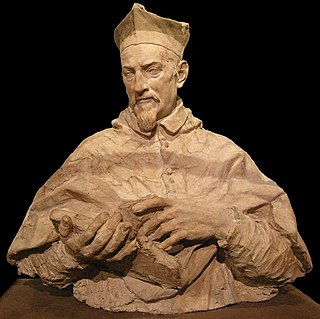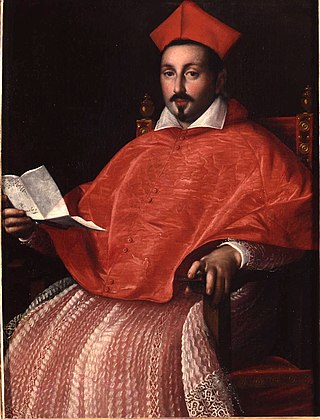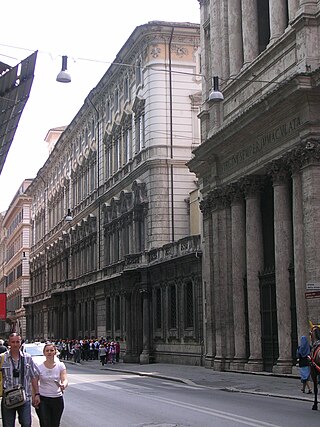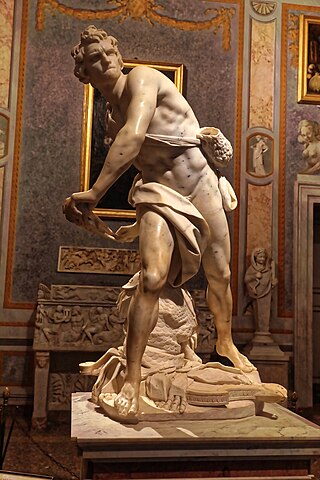
Alessandro Algardi was an Italian high-Baroque sculptor active almost exclusively in Rome, where for the latter decades of his life, he was, along with Francesco Borromini and Pietro da Cortona, one of the major rivals of Gian Lorenzo Bernini. He is now most admired for his portrait busts that have great vivacity and dignity.

Gian LorenzoBernini was an Italian sculptor and architect. While a major figure in the world of architecture, he was more prominently the leading sculptor of his age, credited with creating the Baroque style of sculpture. As one scholar has commented, "What Shakespeare is to drama, Bernini may be to sculpture: the first pan-European sculptor whose name is instantaneously identifiable with a particular manner and vision, and whose influence was inordinately powerful ..." In addition, he was a painter and a man of the theatre: he wrote, directed and acted in plays, for which he designed stage sets and theatrical machinery. He produced designs as well for a wide variety of decorative art objects including lamps, tables, mirrors, and even coaches.

The Galleria Borghese is an art gallery in Rome, Italy, housed in the former Villa Borghese Pinciana. At the outset, the gallery building was integrated with its gardens, but nowadays the Villa Borghese gardens are considered a separate tourist attraction. The Galleria Borghese houses a substantial part of the Borghese Collection of paintings, sculpture and antiquities, begun by Cardinal Scipione Borghese, the nephew of Pope Paul V. The building was constructed by the architect Flaminio Ponzio, developing sketches by Scipione Borghese himself, who used it as a villa suburbana, a country villa at the edge of Rome.

The House of Borghese is a princely family of Italian noble and papal background, originating as the Borghese or Borghesi in Siena, where they came to prominence in the 13th century and held offices under the commune. During the 16th century, the head of the family, Marcantonio, moved to Rome, where they rose in power and wealth following the election of his son Camillo as Pope Paul V in 1605. They were one of the leading families of the Black Nobility and maintain close ties to the Vatican.

Villa Borghese is a landscape garden in Rome, containing a number of buildings, museums and attractions. It is the third-largest public park in Rome, after the ones of the Villa Doria Pamphili and Villa Ada. The gardens were developed for the Villa Borghese Pinciana, built by the architect Flaminio Ponzio, developing sketches by Scipione Borghese, who used it as a villa suburbana, or party villa, at the edge of Rome, and to house his art collection. The gardens as they are now were remade in the late 18th century.

Scipione Borghese was an Italian cardinal, art collector and patron of the arts. A member of the Borghese family, he was the patron of the painter Caravaggio and the artist Bernini. His legacy is the establishment of the art collection at the Villa Borghese in Rome.

The Doria Pamphilj Gallery is a large private art collection housed in the Palazzo Doria Pamphilj in Rome, Italy, between Via del Corso and Via della Gatta. The principal entrance is on the Via del Corso. The palace façade on Via del Corso is adjacent to a church, Santa Maria in Via Lata. Like the palace, it is still privately owned by the princely Roman family Doria Pamphili. Tours of the state rooms often culminate in concerts of Baroque and Renaissance music, paying tribute to the setting and the masterpieces it contains.

David is a life-size marble sculpture by Gian Lorenzo Bernini. The sculpture was one of many commissions to decorate the villa of Bernini's patron Cardinal Scipione Borghese – where it still resides today, as part of the Galleria Borghese. It was completed in the course of seven months from 1623 to 1624.

Aeneas, Anchises, and Ascanius is a sculpture by the Italian artist Gian Lorenzo Bernini created c. 1618–19. Housed in the Galleria Borghese in Rome, the sculpture depicts a scene from the Aeneid, where the hero Aeneas leads his family from burning Troy.

Apollo and Daphne is a life-sized marble sculpture by the Italian artist Gian Lorenzo Bernini, which was executed between 1622 and 1625. It is regarded as one of the artistic marvels of the Baroque age. The statue is housed in the Galleria Borghese in Rome, along with several other examples of the artist's most important early works. The sculpture depicts the climax of the story of Apollo and Daphne, as written in Ovid's Metamorphoses, wherein the nymph Daphne escapes Apollo's advances by transforming into a laurel tree.

The Sleeping Hermaphroditus is an ancient marble sculpture depicting Hermaphroditus life size. In 1620, Italian artist Gian Lorenzo Bernini sculpted the mattress upon which the statue now lies. The form is partly derived from ancient portrayals of Venus and other female nudes, and partly from contemporaneous feminised Hellenistic portrayals of Dionysus/Bacchus. It represents a subject that was much repeated in Hellenistic times and in ancient Rome, to judge from the number of versions that have survived. Discovered at Santa Maria della Vittoria, Rome, the Sleeping Hermaphroditus was immediately claimed by Cardinal Scipione Borghese and became part of the Borghese Collection. The "Borghese Hermaphroditus" was later sold to the occupying French and was moved to The Louvre, where it is on display.

The Rape of Proserpina, more accurately translated as the Abduction of Proserpina, is a large Baroque marble group sculpture by Italian artist Gian Lorenzo Bernini, executed between 1621 and 1622, when Bernini's career was in its early stage. The group, finished when Bernini was just 23 years old, depicts the abduction of Proserpina, who is seized and taken to the underworld by the god Pluto. It features Pluto holding Proserpina aloft, and a Cerberus to symbolize the border into the underworld that Pluto carries Proserpina into.

Truth Unveiled by Time is a marble sculpture by Italian artist Gian Lorenzo Bernini, one of the foremost sculptors of the Italian Baroque. Executed between 1645 and 1652, Bernini intended to show Truth allegorically as a naked young woman being unveiled by a figure of Time above her, but the figure of Time was never executed.

Two Busts of Cardinal Scipione Borghese are marble portrait sculptures executed by the Italian artist Gian Lorenzo Bernini in 1632. Cardinal Scipione Borghese was the nephew of Pope Paul V, and had commissioned other works from Bernini in the 1620s. Both versions of this portrait are in the Galleria Borghese, Rome.

The Bust of Cardinal Richelieu is a marble sculpture by the Italian sculptor Gian Lorenzo Bernini, situated at the Louvre in Paris.

The Italian artist Gian Lorenzo Bernini made two Busts of Pope Paul V. The first is currently in the Galleria Borghese in Rome. 1618 is the commonly accepted date for the portrait of the pope. In 2015, a second bust was acquired by the J. Paul Getty Museum in Los Angeles. It was created by Bernini 1621, shortly after the death of Paul V, and commissioned by his nephew, Cardinal Scipione Borghese. A bronze version of this sculpture exists in the Statens Museum for Kunst, Copenhagen, Denmark.

The Bust of Alessandro Peretti di Montalto is a portrait sculpture by the Italian artist Gian Lorenzo Bernini. Executed in 1622 and 1623, the sculpture is now in the Kunsthalle Hamburg, in Germany. Although possibly mentioned by one of Bernini's early biographers, the bust had been considered lost and therefore makes no appearance in Rudolf Wittkower's catalogue of Bernini’s sculptures of 1955. However, the bust was identified in the 1980s and is now considered an authentic work by Bernini.

The Busts of Pope Innocent X are two portrait busts by the Italian artist Gianlorenzo Bernini of Pope Innocent X, Giovanni Battista Pamphili. Created around 1650, both sculptures are now in the Galleria Doria Pamphili in Rome. Like the two busts of Cardinal Scipione Borghese, it is believed that Bernini created a second version of the bust once a flaw was discovered in the first version. There exist several similar versions of the bust done by other artists, most notably Alessandro Algardi.

Several sculpted busts of Pope Urban VIII were created by the Italian artist Gianlorenzo Bernini, with varying amounts of assistance from other artists in his workshop:
- Palazzo Barberini, Rome, 1623–1624. Marble.
- San Lorenzo in Fonte, 1626. Marble. Assistance by Giuliano Finelli.
- Galleria Nazionale di Arte, Palazzo Barberini, Rome, 1637–1638. Marble.
- Galleria Nazionale di Arte, Palazzo Barberini, Rome. Early 1640s. Marble. Largely the work of an assistant.
- Louvre, Paris. 1640. Bronze.
- Cathedral of Spoleto, 1642. Bronze.
- Collection Principe Enrico Barberini. Early 1640s. Porphyry. Adapted from existing antique statue, largely by assistants.
- Private Collection. 1658. Bronze























